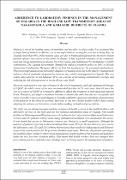| dc.description.abstract | Malaria is one of the leading causes of morbidity and mortality in Africa today. It is estimated that a single bout of malaria in Africa costs a sum equivalent to earning for over ten working days. In Uganda, more than 95% of the malaria cases are due to Plasmodium falciparum, the most virulent parasite species that causes severe forms of disease. It has acquired resistance to the commonly used and cheap antimalarial medicines like Chloroquine and Sulfadoxine/Pyrimethamine (CQ/SP) combination. The Uganda Government changed the malaria treatment policy in 2005 to include Artemisinin Combination Therapies (ACTs) as first line treatment for the uncomplicated malaria. Whereas prompt and accurate laboratory diagnosis of malaria is the key to the effective management malaria, clinical syndromic diagnosis has been the most widely used approach in Uganda. This was widely advocated for in sub-Saharan Africa as a means of increasing antimalarial coverage and reducing the risk of progression to severe disease and death.
However, such practice was only tolerated in the era of inexpensive and safe antimalarial therapy of CQ/SP. An adult course of the new recommended first-line ACTs costs more than 10 times the cost of a course of CQ/SP. It is therefore difficult to afford this treatment at individual and national levels. Therefore, presumptive treatment becomes economically and clinically less acceptable and raises a need for a more accurate diagnosis. To make a definitive diagnosis of malaria, demonstration of the parasite in the blood is essential. However, it was not whether health workers have started adopting the reliance on laboratory results before making antimalarial prescriptions.
The study was an attempt to understand the practices of health workers in the health facilities with laboratory services in one high and one low malaria transmission areas of Uganda. Nine health facilities in Nakasongola and Kabalore were selected on the basis of possession of functional laboratory services and 487 patients with fever/receiving antimalarial treatment were enrolled for the survey. It was found that access to laboratory services was limited to a small population. Although the majority of patients reporting to these health facilities (over 95% for the two districts) were sent to the laboratory, only 52% and 32% of those that received their results for Nakasongola and Kabarole respectively tested positive for the presence of malaria parasites. However, all patients reporting to the health facilities with fever still received antimalarials despite health worker training and guidelines under the new first-line treatment policy. This meant that health workers have not changed their prescription practices and laboratory findings were not being used in the management of malaria. | en_US |


